|

by
Andy Lloyd
December 2001
 I have shown how
ancient knowledge of the 10th Planet 'Nibiru' might underline much of the
arcane symbolism used by the Alchemists. To use modern astronomical
parlance, Nibiru appears to be a 'sub-brown dwarf', or 'light-emitting
planet' several times the mass of Jupiter. Its advanced age has meant that
it no longer shines in the visible spectrum, but is more like a hot gas
giant. Nevertheless, upon returning to the planetary zone, its close
proximity to the Sun and other planets excites the sub-brown dwarf, and
results in a colorful coronal discharge, similar to the powerful brown
dwarf 'flares' discovered by astronomers
(1,
2 -
see below report).
The solar wind sweeps this
coronal discharge back
(3), in a similar fashion to the comets, resulting in
fiery wings. I have shown how
ancient knowledge of the 10th Planet 'Nibiru' might underline much of the
arcane symbolism used by the Alchemists. To use modern astronomical
parlance, Nibiru appears to be a 'sub-brown dwarf', or 'light-emitting
planet' several times the mass of Jupiter. Its advanced age has meant that
it no longer shines in the visible spectrum, but is more like a hot gas
giant. Nevertheless, upon returning to the planetary zone, its close
proximity to the Sun and other planets excites the sub-brown dwarf, and
results in a colorful coronal discharge, similar to the powerful brown
dwarf 'flares' discovered by astronomers
(1,
2 -
see below report).
The solar wind sweeps this
coronal discharge back
(3), in a similar fashion to the comets, resulting in
fiery wings.
The Phoenix mythology has resulted from this incredible display, as well as
the 'son of the Sun' and 'dying-and-rising god' myths. Readers of my book
'Winged Disc: The Dark Star Theory' will be familiar with the arguments I
have used to demonstrate these proposals. Nibiru brings with it a contingent
of 7 moons, a relatively small number when considering the families of
satellites orbiting the gas giants Saturn and Jupiter.
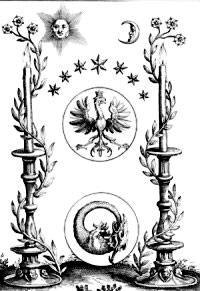 These moons are lit
by the red light of Nibiru when in its excited state at perihelion (its
closest approach to the Sun), and appear as seven stars. It is probable,
given the iconography depicting the Winged Disc, that two of these moons are
much larger than the rest, and are particularly noticeable from Earth, in a
similar way that Jupiter's 4 Galilean moons are visible through binoculars,
in contrast to the other 12. These moons are lit
by the red light of Nibiru when in its excited state at perihelion (its
closest approach to the Sun), and appear as seven stars. It is probable,
given the iconography depicting the Winged Disc, that two of these moons are
much larger than the rest, and are particularly noticeable from Earth, in a
similar way that Jupiter's 4 Galilean moons are visible through binoculars,
in contrast to the other 12.
This alchemical image shows 7 stars above a
crowned eagle
(4). The seven stars are understood by esotericists to stand
for the visible planets: The Sun, Moon, Mercury, Venus, Mars, Jupiter and
Saturn. But here we have them displayed around the eagle, and the Sun and
Moon are already in the field. This makes little sense when
analyzed
conventionally (whatever 'conventional' means when discussing Alchemy!).
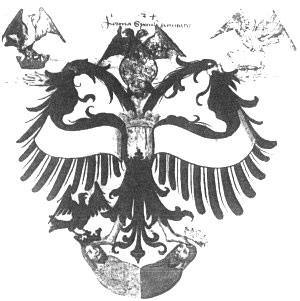 But when the Eagle is understood to depict the 'son' in the celestial
trinity, then the seven stars accompanying this crowned bird could well
indicate dark star symbolism. There are parallels to be made with the
'Talisman of Orpheus' also. Sometimes the Crucified King was even depicted
in the form of the imperial eagle: But when the Eagle is understood to depict the 'son' in the celestial
trinity, then the seven stars accompanying this crowned bird could well
indicate dark star symbolism. There are parallels to be made with the
'Talisman of Orpheus' also. Sometimes the Crucified King was even depicted
in the form of the imperial eagle:
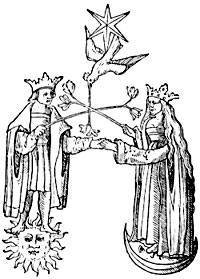 The alchemical
Winged Christ bears some resemblance to the Winged Disc, as
the crown is distinctly disc-like, and the two crowned figures (left) could
be associated with the uraei. The left-hand alchemical image brings the
celestial trinity to mind, with the inclusion of the Star of the Hermes
Bird. Again, a winged star is implied. The alchemical
Winged Christ bears some resemblance to the Winged Disc, as
the crown is distinctly disc-like, and the two crowned figures (left) could
be associated with the uraei. The left-hand alchemical image brings the
celestial trinity to mind, with the inclusion of the Star of the Hermes
Bird. Again, a winged star is implied.
The Reddening
In Alchemy, the 'work' is divided into four quarters, and these are denoted
by colors. The first is the 'Blackening', associated with a watery albedo.
I suggest this is equivalent to the darkness of the Primordial Deep. The
second is the 'Whitening' (symbolized by a white rose), and the third with
the 'Yellowing' which is "represented by an eagle winging towards the Sun".
If the opus is simply connected with the motion of the Sun around the
Zodiac, then what of the focus upon this winged eagle? Could we be receiving
knowledge about the appearance of that other hidden 'sun', Nibiru? In other
words, Nibiru comes out of the darkness, initially appearing as a white,
Jupiter-like planet, then becoming yellower as its stellar character begins
to become excited. Fabricius has the following to add:
"Speaking of the circular work and its fuel, an alchemist says: 'The fire is
enkindled by an invisible sun unknown to many, that is, the sun of the
philosophers'..."
(4)
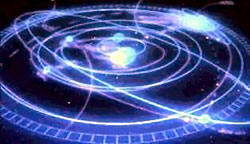 This astronomical allusion is strengthened by the symbolism of the
Ouroborus,
the dragon/serpent who eats its own tail. We can clearly see this imagery
used with the Imperial Eagle depiction above, and this 'Uroboric symbol'
is
said to be central to the fourth and final quarter of the alchemical opus.
This fourth quarter, which completes the work, is the 'Reddening', or
Rubedo,
and is associated with a 'glowing lion'. The Lion is a solar animal in its
own right, but it also takes the form of Chnoubis, whose imagery follows the
now familiar syncretism of solar and serpentine symbols. This astronomical allusion is strengthened by the symbolism of the
Ouroborus,
the dragon/serpent who eats its own tail. We can clearly see this imagery
used with the Imperial Eagle depiction above, and this 'Uroboric symbol'
is
said to be central to the fourth and final quarter of the alchemical opus.
This fourth quarter, which completes the work, is the 'Reddening', or
Rubedo,
and is associated with a 'glowing lion'. The Lion is a solar animal in its
own right, but it also takes the form of Chnoubis, whose imagery follows the
now familiar syncretism of solar and serpentine symbols.
In other words, its solar characteristic may have become embedded in the
duality of this dark sun. As Nibiru moves nearer to the inner planets of the
solar system, its countenance becomes blazing red, appearing either as a
winged firebird, or a fiery comet, depending upon its relative position with
respect to Earth and the Sun. It became the dark solar serpent of Gnostic
syncretism two millennia ago.
Splendor Solis
The most beautiful iconography that Alchemy has to offer is in the form of
the 'Splendor Solis':
"The earliest version, considered to be that now in the
Kupferstichkabinett
in the Prussian State Museum in Berlin, is dated 1532-35, and was made in
the form of a medieval manuscript and illuminated on vellum, with decorative
borders like a book of hours, beautifully painted and heightened with gold.
The work itself consists of a sequence of 22 elaborate images, set in
ornamental borders and niches. The Splendor Solis was associated with the
legendary Salomon Trismosin, allegedly the teacher of Paracelsus."
(5)
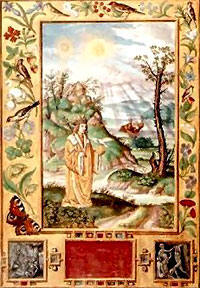 There is a series of three images in the
Splendor Solis that encapsulates
the perihelion transit of Nibiru wonderfully. The first is that of the
'drowning king', denoting the fate of the old king, seen here in the
background of the landscape. In the foreground is the young new king. These
two kings are symbolized by the appearance in the sky of two suns!
To ensure
that we do not miss the importance of this image, the new king is to be seen
holding a red disc, upon which is the Hermes Bird (some have understood this
to be a red apple). In his other hand is a scepter, and seven stars are to
be seen glittering around its end (although this image unfortunately has not
picked up this important detail). There is a series of three images in the
Splendor Solis that encapsulates
the perihelion transit of Nibiru wonderfully. The first is that of the
'drowning king', denoting the fate of the old king, seen here in the
background of the landscape. In the foreground is the young new king. These
two kings are symbolized by the appearance in the sky of two suns!
To ensure
that we do not miss the importance of this image, the new king is to be seen
holding a red disc, upon which is the Hermes Bird (some have understood this
to be a red apple). In his other hand is a scepter, and seven stars are to
be seen glittering around its end (although this image unfortunately has not
picked up this important detail).
To me, this quite evidently denotes the appearance of the hidden sun,
characterized by the young king with his winged red disc and seven stars. In
fact, I don't think this could be clearer. Other commentators might prefer a
more esoteric meaning, and they are welcome to read all kinds of wonderful
ideas into this painting. But the source of the celestial symbolism seems to
be the perihelion appearance of Nibiru and its moons. This assertion is
supported by the next two paintings in the series, whereby the disc appears
to redden and eventually amalgamate with a familiar stellar goddess.
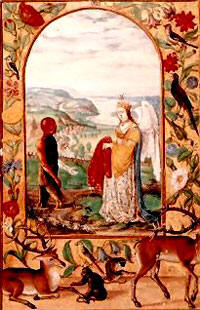 For alchemists and later
esoteric commentators, the source of the 'red
slave' seen here remains somewhat of a mystery, as does the nature of the
peculiar red disc emblazoned upon his face. Fabricius places this image
within a psychoanalytical context: For alchemists and later
esoteric commentators, the source of the 'red
slave' seen here remains somewhat of a mystery, as does the nature of the
peculiar red disc emblazoned upon his face. Fabricius places this image
within a psychoanalytical context:
"In a remarkable manner, the white woman or angelic queen is depicted as
pregnant with her approaching lover, thus expressing the strange Hermetic
marriage in which the bride is sister and mother, and the spouse is father,
brother and suckling rolled into one."
(4)
Well, this might please those of a more
Freudian bias, but I prefer a much
simpler explanation. The white queen is crowned with a five-pointed star,
and is evidently Isis, denoting
Sirius
(6). The red figure is the returning
red planetary disc of Nibiru, climbing out of the darkness of the
Primordial
Deep. In other words, Nibiru is brightening and reddening as it approaches
Sirius. The pregnant Isis is even holding a red cloak for the approaching
Horus, or Nibiru, implying that the brown dwarf is about to become glorified
by a red cloak (its coronal halo), as it flares up during perihelion. Around
2000 years ago, this celestial cloak created the 'red Sirius' anomaly.
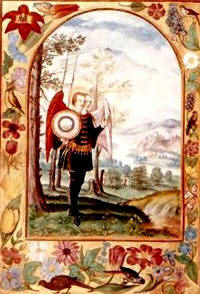 This is where one of the most wonderful images of Alchemical allegory comes
into play. As the brilliant brown dwarf casts its red cloak over the
Dog
Star, there is a fusion of Mother and Son as Isis and
Horus join to become a
celestial hermaphrodite, or 'rebus'. This may only have lasted for a matter
of days, but the conjunction of the 10th 'Planet' with the brightest star in
the sky must have been an awe-inspiring spectacle. In previous web-pages, I
have looked in some detail at how this rare astronomical event became the
seed from which would grow some of our most important religious and
mythological ideas. This is where one of the most wonderful images of Alchemical allegory comes
into play. As the brilliant brown dwarf casts its red cloak over the
Dog
Star, there is a fusion of Mother and Son as Isis and
Horus join to become a
celestial hermaphrodite, or 'rebus'. This may only have lasted for a matter
of days, but the conjunction of the 10th 'Planet' with the brightest star in
the sky must have been an awe-inspiring spectacle. In previous web-pages, I
have looked in some detail at how this rare astronomical event became the
seed from which would grow some of our most important religious and
mythological ideas.
This takes us beyond the resurrection and rebirth
symbolism, however centrally important that may be. The celestial
conjunction of Nibiru with Sirius leads us to the deeper mysteries. For
instance, its symbolism is noted by the inclusion of the 'Star of Napoleon'
inside the Winged Disc on the frontispiece of the 'Description de L'Egypte'
(6).
In this third image from the Splendor Solis, the white goddess has combined
with the red god, rounding the circle of the ouroborous, and amalgamating
the Opposites. This image denotes the perihelion point of the dark star, and
the completion of the Great Work.
"Uroboric symbols of the completed work abound in the rubedo"
(4)
Christ and the Eighth Sphere
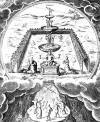 Just as the various
Orders of Freemasonry each reflect different aspects of
the attainment of spiritual knowledge, so are the mysteries multi-faceted.
Many Masonic Orders are Christian in character, yet others have a more
eclectic appeal, and the Societas Rosicruciana in Anglia in particular
advocates the study of many diverse, often esoteric traditions, including
alchemy and astronomy
(7). It may be a shock to many to see
Christ
demonstrably depicted as a planet in this alchemical image
(8), but His
presence seems to identify Him as the Eighth Star, or celestial sphere.
Allow me to explain. Just as the various
Orders of Freemasonry each reflect different aspects of
the attainment of spiritual knowledge, so are the mysteries multi-faceted.
Many Masonic Orders are Christian in character, yet others have a more
eclectic appeal, and the Societas Rosicruciana in Anglia in particular
advocates the study of many diverse, often esoteric traditions, including
alchemy and astronomy
(7). It may be a shock to many to see
Christ
demonstrably depicted as a planet in this alchemical image
(8), but His
presence seems to identify Him as the Eighth Star, or celestial sphere.
Allow me to explain.
On right, can be found the Sun and Moon worshipping
Christ within the
Philosophers' Garden. Christ is evidently not representative of the Sun.
Below them are the five visible planets, marked by their astrological
sigils.
The globe of Christ's crown finds itself incorporated into the lower
fountain, shaped as a crescent, and this forms the familiar Winged Disc
symbol. He holds two goblets, again in keeping with the two uraei of the
Winged Disc emblem. The 5 planets, Mercury, Saturn
and Jupiter, and Mars and Venus, are again depicted within the fountains. Evidently Christ is an
unknown quantity, and is neither the Sun, nor Mercury, nor
Jupiter, as they
are all present independently.
This remarkable image provides us with a new piece of data; a view of the
orbit of Nibiru. Like a rounded wedge, the Hermes Bird traces a faint line
between the Sun, the Red King and a celestial Jerusalem (the Kingdom of
Heaven?). Our elliptical orbit appears to be distinctly wedge-shaped
according to the artist S. Michelspacher. Whether this denotes an egg-shaped
cometary path, or is an allusion to the perspective of the orbital path as
seen from the Earth, the one thing we can be sure of is this: The Red King
of the Rubedo traces an orbit around the Sun, and it
does not follow a
traditional, roughly circular planetary path.
I will leave it to the reader to decide whether or not this indicates
Christ's actual equivalence with the Messianic Star. I am quite convinced
that the original Christian mystery revolved around the conjunction of
Nibiru at perihelion with Sirius. It was an adaptation of the ancient
Egyptian mysteries of Horus and Isis. That knowledge became heretical as the
Romanized cult of Jesus attained greater power, but we can still access its
original symbolism through the works of the alchemists and the
Rosicrucians.
No doubt more remains to be discovered in the most secretive of Masonic Orders, but from what evidence is openly available I find this case
increasingly compelling.
1. Reuters, 11 July 2000, By Deborah Zabarenko, Washington
2. K. Leutwyler "Bright X-rays, Dim Dwarfs" 17/7/00
Click
HERE
3. G. Webster "Jupiter Particles' Escape Route Found" 31/5/01
http://sse.jpl.nasa.gov/news/display.cfm?News_ID=979
4. J. Fabricius "Alchemy: The Medieval Alchemists and their Royal Art"
"Between the marriage of Sol and Luna the tail-eater coils up in his primal
cell, thus completing the opus circulatorium in the sign of the imperial
eagle and the sevenfold planetary star." p193, also p14-5, 94 Aquarian 1989
5. 'Alchemy'
http://www.levity.com/alchemy/home.html
6. R. Bauval "Secret Chamber" pp330-343 Century 1999
7. M. Stayt "The Rungs of the Ladder" pp68-73 Flying Dragon Publications
1999
8. S. Michelspacher "Cabala: 4. The End. Multiplication"
|

 These moons are lit
by the red light of Nibiru when in its excited state at perihelion (its
closest approach to the Sun), and appear as seven stars. It is probable,
given the iconography depicting the Winged Disc, that two of these moons are
much larger than the rest, and are particularly noticeable from Earth, in a
similar way that Jupiter's 4 Galilean moons are visible through binoculars,
in contrast to the other 12.
These moons are lit
by the red light of Nibiru when in its excited state at perihelion (its
closest approach to the Sun), and appear as seven stars. It is probable,
given the iconography depicting the Winged Disc, that two of these moons are
much larger than the rest, and are particularly noticeable from Earth, in a
similar way that Jupiter's 4 Galilean moons are visible through binoculars,
in contrast to the other 12.  But when the Eagle is understood to depict the 'son' in the celestial
trinity, then the seven stars accompanying this crowned bird could well
indicate dark star symbolism. There are parallels to be made with the
'Talisman of Orpheus' also. Sometimes the Crucified King was even depicted
in the form of the imperial eagle:
But when the Eagle is understood to depict the 'son' in the celestial
trinity, then the seven stars accompanying this crowned bird could well
indicate dark star symbolism. There are parallels to be made with the
'Talisman of Orpheus' also. Sometimes the Crucified King was even depicted
in the form of the imperial eagle:  The alchemical
Winged Christ bears some resemblance to the Winged Disc, as
the crown is distinctly disc-like, and the two crowned figures (left) could
be associated with the uraei. The left-hand alchemical image brings the
celestial trinity to mind, with the inclusion of the Star of the Hermes
Bird. Again, a winged star is implied.
The alchemical
Winged Christ bears some resemblance to the Winged Disc, as
the crown is distinctly disc-like, and the two crowned figures (left) could
be associated with the uraei. The left-hand alchemical image brings the
celestial trinity to mind, with the inclusion of the Star of the Hermes
Bird. Again, a winged star is implied.  This astronomical allusion is strengthened by the symbolism of the
Ouroborus,
the dragon/serpent who eats its own tail. We can clearly see this imagery
used with the Imperial Eagle depiction above, and this 'Uroboric symbol'
is
said to be central to the fourth and final quarter of the alchemical opus.
This fourth quarter, which completes the work, is the 'Reddening', or
Rubedo,
and is associated with a 'glowing lion'. The Lion is a solar animal in its
own right, but it also takes the form of Chnoubis, whose imagery follows the
now familiar syncretism of solar and serpentine symbols.
This astronomical allusion is strengthened by the symbolism of the
Ouroborus,
the dragon/serpent who eats its own tail. We can clearly see this imagery
used with the Imperial Eagle depiction above, and this 'Uroboric symbol'
is
said to be central to the fourth and final quarter of the alchemical opus.
This fourth quarter, which completes the work, is the 'Reddening', or
Rubedo,
and is associated with a 'glowing lion'. The Lion is a solar animal in its
own right, but it also takes the form of Chnoubis, whose imagery follows the
now familiar syncretism of solar and serpentine symbols.  There is a series of three images in the
Splendor Solis that encapsulates
the perihelion transit of Nibiru wonderfully. The first is that of the
'drowning king', denoting the fate of the old king, seen here in the
background of the landscape. In the foreground is the young new king. These
two kings are symbolized by the appearance in the sky of two suns!
To ensure
that we do not miss the importance of this image, the new king is to be seen
holding a red disc, upon which is the Hermes Bird (some have understood this
to be a red apple). In his other hand is a scepter, and seven stars are to
be seen glittering around its end (although this image unfortunately has not
picked up this important detail).
There is a series of three images in the
Splendor Solis that encapsulates
the perihelion transit of Nibiru wonderfully. The first is that of the
'drowning king', denoting the fate of the old king, seen here in the
background of the landscape. In the foreground is the young new king. These
two kings are symbolized by the appearance in the sky of two suns!
To ensure
that we do not miss the importance of this image, the new king is to be seen
holding a red disc, upon which is the Hermes Bird (some have understood this
to be a red apple). In his other hand is a scepter, and seven stars are to
be seen glittering around its end (although this image unfortunately has not
picked up this important detail).  For alchemists and later
esoteric commentators, the source of the 'red
slave' seen here remains somewhat of a mystery, as does the nature of the
peculiar red disc emblazoned upon his face. Fabricius places this image
within a psychoanalytical context:
For alchemists and later
esoteric commentators, the source of the 'red
slave' seen here remains somewhat of a mystery, as does the nature of the
peculiar red disc emblazoned upon his face. Fabricius places this image
within a psychoanalytical context:  This is where one of the most wonderful images of Alchemical allegory comes
into play. As the brilliant brown dwarf casts its red cloak over the
Dog
Star, there is a fusion of Mother and Son as Isis and
Horus join to become a
celestial hermaphrodite, or 'rebus'. This may only have lasted for a matter
of days, but the conjunction of the 10th 'Planet' with the brightest star in
the sky must have been an awe-inspiring spectacle. In previous web-pages, I
have looked in some detail at how this rare astronomical event became the
seed from which would grow some of our most important religious and
mythological ideas.
This is where one of the most wonderful images of Alchemical allegory comes
into play. As the brilliant brown dwarf casts its red cloak over the
Dog
Star, there is a fusion of Mother and Son as Isis and
Horus join to become a
celestial hermaphrodite, or 'rebus'. This may only have lasted for a matter
of days, but the conjunction of the 10th 'Planet' with the brightest star in
the sky must have been an awe-inspiring spectacle. In previous web-pages, I
have looked in some detail at how this rare astronomical event became the
seed from which would grow some of our most important religious and
mythological ideas. 